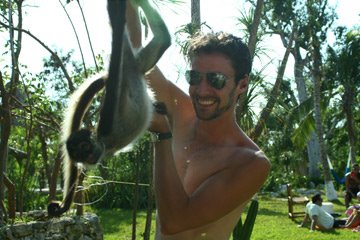Eats
When you're in a strange place making friends and meeting people, much of your activities end up revolving around food. It's some of the essential glue of human social interaction. And when you don't know what else to do, you can always snack. A charming little bit of Myanmar society is the teashop. You sit down at a little table on a little kindergarten-sized stool. There is always a pitcher of weak Chinese tea on the table and a few little cups in a bowl of water when you sit, and then shortly after you sit and order a cup of myanmar tea (strong black tea with sweetened condensed milk), several plates of little snacks appear at your table. Little somosas, bits of fried dough that resemble crullers, small cubes of sweetened and flavored sticky rice, discs of fried dough stuffed with sweetened black beans, sometimes packaged pastries, oily fried springrolls, squares of eggy custard, things like that. It varies from place to place. At first your reaction is what the christ am I going to do with all this food, but then you get used to the idea that you don't pay for what you don't eat. It's easy to meet people in the teashops, especially because you stick out like a fart in an elevator. I drew a few portraits of strangers in some, men playing chess or watching television being good subjects. (The hand as gotten very rusty!) It's a nicer way to approach someone and record their image than simply taking a picture. Plus, if you've put in the effort already, they're usually happy to have you shoot their picture. The teashops and the temples are the centers of Myanmar social life. There are bars here and there, but as far as I can tell, the only people who can afford to drink beer are tourists, soldiers, and a some businessmen. In addition, the whole country turns into a pumpkin around ten at night. It's as silent as the basement of a morgue at night. All the bustle of the street evaporates, the umbrellas and fry stalls and betel-nut sellers and trishaw drivers, the cheroot hawkers and the shouting garbage collectors and girls with platters of fruit on their heads, all of what makes the streets a congested muddy swirl in the day, it's all gone by around nine-thirty.
What food you find in the teashops reflects the influences of how many different people have lived there. Chinese and Indian snacks accompanying Nepali-style tea, all of it with a Burmese twist. It's a huge country, as big as Texas with a population of sixty million. Indians, Nepalis, Bamar, Mon, Chinese, Chins, Kachins, Shan, Kayin, so many groups. This place used to be a bigger deal than Thailand. You see the cracked and charred husks of several empires here. The older one, which left all the temples and stupas behind, was the kingdom of the Bamar kings. More recently and briefly, but still relatively visible, is the Empire of the British. You don't see too much British colonial architecture outside of Yangon, but the presence is still there. Roads, railways, those things that the Brits are good at. I met a batty old woman who was still pining for the days of the British. Apparently that's not so uncommon among people who predate the second world war. They got stuff done a whole lot better than the current assholes.
But overall, I'm thrilled to be back in Thailand, foodwise. Much of the food in Myanmar does not have the richly layered flavors of Thai food. A lot of fried carby stuff. Fried rice, fried noodles. Those are the staples. Gloppy curries without the delicacy of flavor that you find in some Thai and Indian curries. The Indian food was the best food that I had there. I had one meal at a north Indian restaurant in Bagan that was to die for. It was sort of a splashout expensive meal, mutton curry for 2500 kyat, almost two dollars! But it was unbelievably good after that horrendous minibus ride from Meiktila. A mutton curry with Chapatis and five different little pickled accompaniments to make each bite taste different. Fried onions and garlic, pickled mango, tamarind paste, maybe pickled bamboo shoots, and a different amarind paste. It was spectacular.
A staple of the Shan diet is wheat noodles, and one of their staple crops is tomatoes. So not surprisingly, in Shan state you can get a really good plate of homemade Italian pasta. Wheat, tomatoes, garlic, onions. Those are all native.
Note to future travelers: It's a "don't finish the whole plate" country, not a "clean your plate country". If you empty a plate, it gets refilled. And people are constantly handing their dishes back to the server or cook for further modifications and additions. You get used to it.


0 Comments:
Post a Comment
<< Home